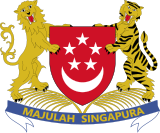| This article is part of a series on |
 |
|---|
|
|
The Separation of powers in Singapore is governed by Constitution of the Republic of Singapore, which splits the power to govern the country between three branches of government – the parliament, which makes laws; the executive, which executes them; and the judiciary, which enforces them. Each branch, while wielding legitimate power and being protected from external influences, is subject to a system of checks and balances by the other branches to prevent abuse of power. This Westminster constitutional model was inherited from the British during Singapore's colonial years.
The Singapore system of government, as with those of a number of other Commonwealth jurisdictions, exhibits a partial separation of powers. The ministers of the Cabinet, who govern the executive branch of government, are appointed from the Members of Parliament (MPs). The cabinet both comes from and drives the parliament's legislative agenda. In addition, the executive possesses law-making power as it is authorised to issue subsidiary legislation, and the President of Singapore is a member of both the executive and the legislature.
The legislature can exercise checks upon the executive by imposing weak sanctions through the doctrine of individual ministerial responsibility. Cabinet ministers may be called upon to justify their policies in Parliament by elected MPs (backbenchers belonging to the ruling party and opposition MPs), as well as non-elected Members (non-constituency members of parliament (NCMPs) and nominated members of parliament (NMPs)).
The judiciary has the role of safeguarding the constitution, and is able to act as an institutional check through its inherent power to strike down unconstitutional laws. The Supreme Court may also invalidate acts or decisions by the executive which are inconsistent with the Constitution or with administrative law rules. However, judicial power is not unfettered and is also restrained by constitutional and legislative prohibitions. The judiciary also defers to the executive where non-justiciable matters are involved. Judicial independence in Singapore allows the judiciary powers to check the exercise of power by the other branches of government, strengthening the separation of powers. Constitutional safeguards exist to secure the independence of Supreme Court judges, but a point of contention is that State Courts judges do not enjoy security of tenure as they are members of the Singapore Legal Service and may be transferred out of the State Courts to other departments of the Service by the Legal Service Commission.
The separation of powers in Singapore is also enhanced by intra-branch checking mechanisms. Within the executive, the elected president adds to the overall scheme of checks and balances through his discretionary power to block certain government actions. However, the presence of an override mechanism wielded by Parliament blunts the office's powers. The Presidential Council for Minority Rights also serves as a check on the legislature by reviewing bills to ensure that they do not discriminate against racial and religious minorities. However, the Council's powers are constrained by the presence of an override mechanism as well.
Some have criticised the government of Singapore as disregarding constitutionalism and the separation of powers in favour of pragmatism. Former Attorney-General Walter Woon said of Singapore's legal system: "We effectively don't have a Constitution. We have a law that can be easily changed by Parliament, and by the party in power because the party is Parliament."[1]
- ^ Sumiko Tan (6 July 1991), "Stand up and be quoted", The Straits Times, p. 28.
© MMXXIII Rich X Search. We shall prevail. All rights reserved. Rich X Search
